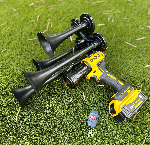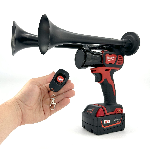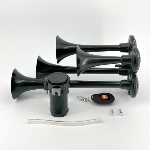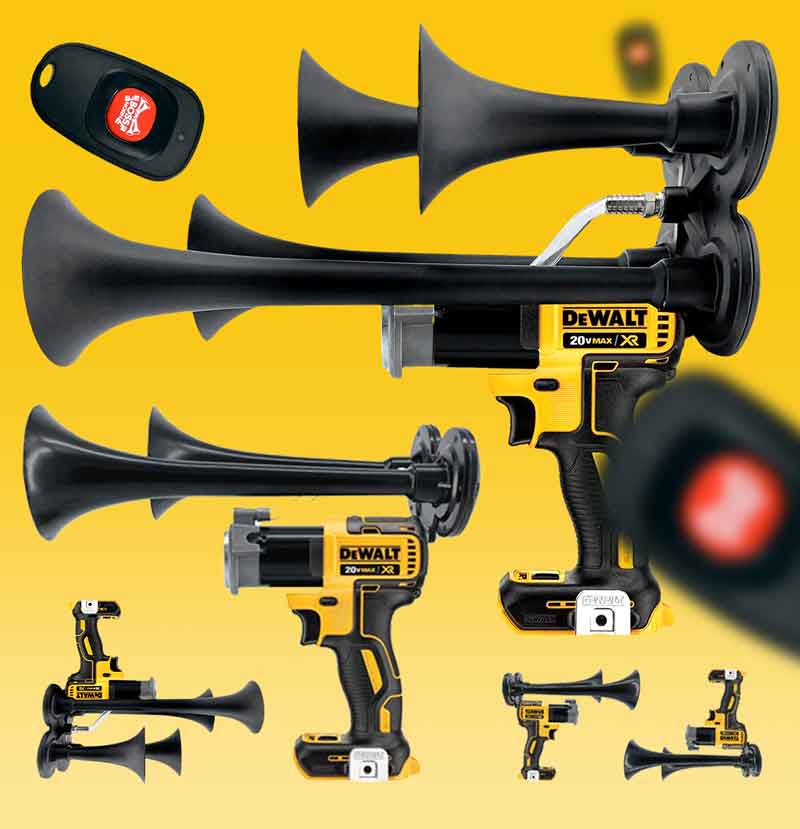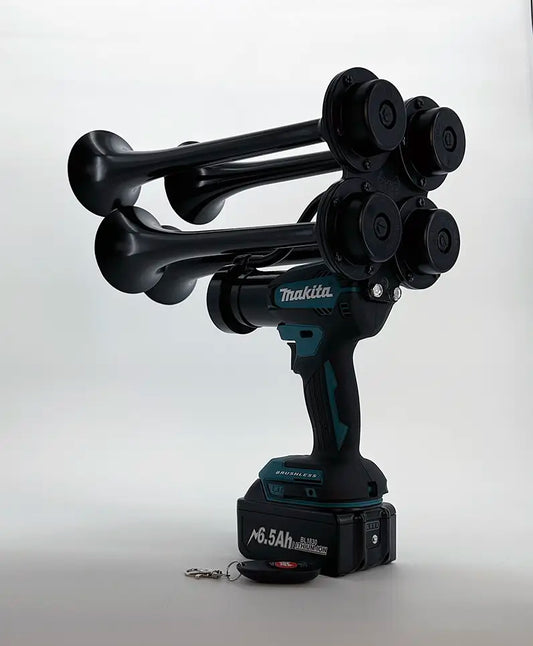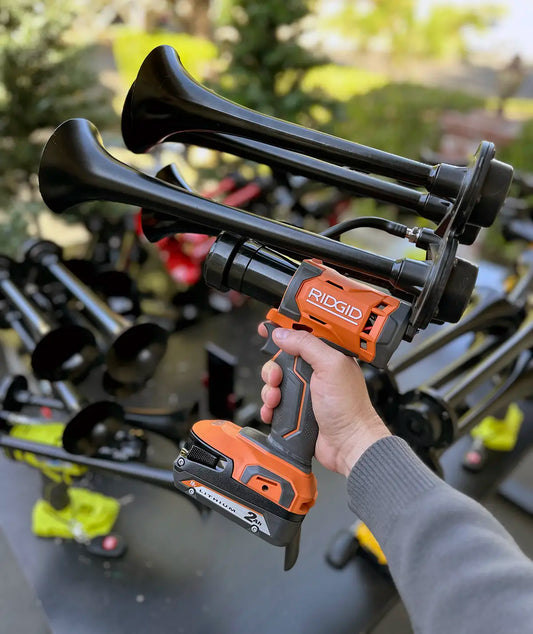An air horn is a signaling device that produces a loud sound by the vibration of a diaphragm. These horns are commonly used in various settings such as sporting events, emergency situations, and even on boats to alert others of potential danger or to add excitement to celebrations. Unlike traditional metal horns, modern air horns are powered by compressed gas, which allows them to generate a much louder and more sustained sound.
The gas used in air horns is stored under high pressure in a canister or container attached to the horn. When the horn is activated, the gas is released through a valve mechanism that causes the diaphragm to vibrate rapidly, producing a powerful sound wave. This method of operation not only ensures a loud and attention-grabbing noise but also allows for the horn to be easily refilled or replaced when needed.
One of the key benefits of using compressed gas in air horns is that it provides a reliable and consistent source of power for producing loud sounds. This is particularly important in emergency situations where a clear and audible warning signal can make a significant difference in alerting others to potential hazards. In fact, studies have shown that the use of air horns in emergency response vehicles has helped to reduce response times and increase overall safety for both first responders and the public.
Overall, the use of compressed gas in air horns has revolutionized the way we communicate and signal others in a variety of situations. From sports events to marine safety, these powerful devices continue to play a crucial role in alerting and informing people across different industries and settings.
What type of gas is typically found in an air horn?
Air horns generally use compressed air or a canister of gas, such as CO2, to create the loud sound when activated. The gas is released quickly through a small opening, causing vibrations that produce the loud noise associated with air horns. The choice of gas can affect the volume and duration of the sound produced by the air horn. In the next section, we will explore the different types of gases used in air horns and their impact on performance.
An air horn is a popular noisemaking device that is often used at events, sporting events, and in emergency situations. Many people wonder what type of gas is used in an air horn to produce the loud sound that it is known for. The gas typically used in an air horn is compressed air or a mixture of gases such as air and CO2.
Compressed air is the most common gas used in air horns. It is simply air that has been pressurized, usually to a high pressure. When the air horn is activated, the compressed air is released rapidly, causing the loud noise that is characteristic of an air horn. Some air horns also use a combination of compressed air and CO2 to produce an even louder sound.
CO2, or carbon dioxide, is often used in air horns because it is easily compressed and can produce a loud sound when released quickly. When CO2 is released from the air horn, it expands rapidly, creating a loud, horn-like noise. However, CO2 can be dangerous if not handled properly, so it is important to follow safety precautions when using an air horn that contains CO2.
Overall, the gas in an air horn is typically compressed air or a mixture of gases such as air and CO2. These gases are what allow the air horn to produce its loud, attention-grabbing sound that is perfect for a variety of situations.
- According to a study, air horns are capable of producing sound levels of up to 130-140 decibels, which is comparable to the noise level of a jet engine taking off.
- The sound produced by an air horn can travel long distances, making it an effective tool for signaling and alerting others in emergency situations.
https://youtube.com/watch?v=xZgdKCsHFoY
What gas is commonly used in air horns?
The gas used in air horns is selected for its ability to produce loud and sharp sound when the horn is triggered. It is important for creating the desired effect and alerting people of potential dangers or events. The specific gas used is designed to amplify the sound produced by the air horn, making it highly effective in various situations.
- The gas used in air horns is chosen for its sound amplification properties.
- The gas is crucial for creating the desired effect of alerting people in various situations.
- The specific gas used in air horns is selected for its ability to produce loud and sharp sounds.
Is the gas in air horns safe for the environment?
The gas used in air horns is carefully selected to minimize its impact on the environment. It is designed to be non-toxic and non-polluting, ensuring that it does not harm the environment when released into the air. The gas in air horns is also chosen for its ability to quickly dissipate, reducing its impact on the surrounding environment.
- The gas in air horns is chosen for its minimal impact on the environment.
- The gas is designed to be non-toxic and non-polluting.
- The gas in air horns quickly dissipates, reducing its impact on the environment.
Can the gas in air horns be harmful to humans?
The gas used in air horns is selected to be safe for human use. It is designed to be non-toxic and non-irritating, ensuring that it does not harm individuals who come into contact with it. The gas in air horns is also chosen for its ability to be easily dispersed, minimizing the risk of prolonged exposure to harmful effects.
- The gas in air horns is chosen to be safe for human use.
- The gas is designed to be non-toxic and non-irritating.
- The gas in air horns easily disperses, reducing the risk of harmful effects from prolonged exposure.
Is the gas in air horns flammable?
The gas used in air horns is selected for its non-flammable properties. It is chosen to be safe for use in various environments where flammable gases could pose a risk. The gas in air horns is designed to be stable and not easily ignited, making it a safe option for creating loud sound effects.
- The gas in air horns is chosen for its non-flammable properties.
- The gas is safe for use in environments where flammable gases could pose a risk.
- The gas in air horns is stable and not easily ignited.
How long does the gas in air horns last?
The duration of the gas in air horns varies depending on the model and size of the air horn. Some air horns are designed to be disposable, meaning that once the gas is used up, the entire unit is discarded. Other air horns can be refilled with gas, extending their lifespan and usability. The length of time the gas in air horns lasts also depends on how frequently the horn is used.
- The duration of the gas in air horns varies depending on the model and size of the air horn.
- Some air horns are disposable, while others can be refilled with gas.
- The lifespan of the gas in air horns is influenced by how frequently the horn is used.
Conclusion
In conclusion, the gas typically used in an air horn is compressed air. This gas is easy to obtain and safe for use in a variety of applications. The pressurized air creates the loud noise that air horns are known for, making them effective signaling devices for emergencies or sporting events. Overall, compressed air is the most practical and reliable gas choice for air horns.


